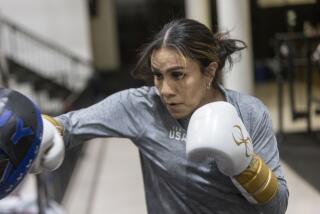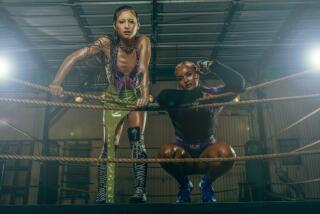A Fistful of Desire : After Winning National Title, Pepe Reilly Takes Aim at Olympics
- Share via
Outside Resurrection Gym, in a fierce East Los Angeles neighborhood, a young man named Pepe emerges from a car.
Pepe is looking for a fight.
But this kid carries no gang affiliation. Not a single tattoo mars his body. No red or blue or green bandanna is knotted around his head.
The young man is Pepe Reilly, and the only fight he is looking for is inside the gym, inside the boxing ring and within the rules. His weapons will be a pair of heavily padded fists. And although it is all perfectly legal, Reilly, possessing the combination of a dancer’s grace and the quickness of a fox, is about to commit a drive-by beating, even though a heavier and stronger sparring partner awaits.
Reilly, 19, of Glendale, has risen to the top of the United States’ amateur boxing program. He capped a decade-long rehearsal in junior and Golden Gloves tournaments by winning the national amateur boxing championship in early March in the 147-pound division.
Slightly more than a year from now, Reilly hopes to bring it up another notch, to rise to the ultimate plateau in amateur boxing. He wants to fight for the gold medal in Barcelona in the 1992 Olympics. And many, including Reilly, think there is not very much standing in his way.
“Pepe has come a long way since I first met him two years ago,” said Pat Nappi, the veteran trainer and longtime coach of the U. S. Olympic boxing team. “He’s a very well-schooled boxer and, with some international experience, he’s got great, great potential. The Olympics? It’s a real possibility for him. He’s got all the right skills to make it.”
All of which would come as a shock to anyone meeting Reilly for the first time. His eyes are those of a doe, soft and brown and innocent-looking. No scar tissue here. And not a hint of a fighter’s meanness burning from these sockets. His complexion is as smooth as a con man’s pitch. Not a single mark scars his face, and his ears show not a trace of the shredded and gnarled tissue that very often announces the presence of a prizefighter.
When Reilly speaks, the voice is confident but soft and subdued. His words are bright and concise, sometimes even eloquent. In a sport overwhelmed by images of a snarling Mike Tyson or a babbling Mitch (Blood) Green, Reilly has emerged as a potential ambassador for it.
None of which should imply that Reilly has ever hesitated to give an opponent a traditional smash to the chops. He unloads heaps of punishment on foes quite often. You don’t win anything in this sport by dancing and moving gracefully and speaking well. He could have eased up in the final bout of the U. S. Amateur Boxing Championships in Colorado Springs, Colo., on March 2, having already piled up an insurmountable lead over Pat Briceno of Vancouver, Wash.
But he didn’t.
In the closing seconds of the fight, Reilly trapped Briceno against the ropes and pummeled him, ending the furious attack with a right to the jaw that snapped Briceno’s head back and briefly disconnected him from his senses. The knockdown was the exclamation point to Reilly’s championship sentence.
“Boxing has an image of bad people,” Reilly said. “It has an image of being nothing but crazy people, madmen always shooting off their mouths and bragging about everything and talking about killing someone or ripping their head off. But not all boxers are like that. I’ve met so many nice people in boxing. Really nice people.”
The national amateur championship came after 11 years of organized boxing. But the 11 years have been kind to Reilly. Unlike the big punchers who are perfectly willing to take five thuds to the head to deliver their bomb or the kids who seem to have been born with chins of iron and spend years showing it off, Reilly has not been the recipient of many hard punches.
At the age of 8, Reilly and his father-trainer-manager Fred (Fellini) Reilly understood the significance of the ability to duck in this sport. And few amateurs have ever ducked better than Reilly.
“Boxers sometimes talk about getting hit like it’s no big deal,” Reilly said. “Well, most of them are lying. For me, getting hit was a very big deal. It hurt. I hated it. So I made up my mind when I was just a kid that if I was going to stay with boxing and become good at it, I wasn’t going to allow myself to get hit very often.
“Even now, I hate to get hit. I’d quit boxing if I got hit very much. Now, against bigger and stronger guys, getting hit really hurts. So it’s more important than ever for me to not get hit, to work on my defense even more.”
When Reilly began boxing he weighed 53 pounds, about the weight of an average collie. The gloves appeared to be sofa cushions on his tiny arms and the protective leather headgear looked like a brown trash can on his head. He was not, as one might imagine, very menacing. And as recently as 1988, he was fighting at only 106 pounds and still projecting the image of a very young boy, even though he was 17.
But in the past two years, the body created by his Philadelphia-born father and his Guatemalan-born mother, Socorro, finally began to grow. Now, at 5-foot-11 and 147 pounds, he has maintained and even improved upon his defensive skills. But the added size has given Reilly the thing opponents hoped he would never get. Power. It was one thing to get outpointed by the swift, thin and highly elusive Reilly. At least you never got hurt. Now, opponents know that after they miss Reilly, the counterpunch might turn out their lights.
It is a feeling that Reilly is just learning to deal with. So far, he likes it. A lot.
“Knocking a guy down or out makes you feel really strong,” Reilly said. “It makes you feel like you can do anything, that you can knock out anyone. But after those first few seconds, I usually just feel relief. Relief that the fight is over and I won’t have to worry about what the judges thought, and relief when the man gets up that no one really got hurt.”
As you might have guessed from a glimpse of Reilly’s personality, his out-of-the-ring hobbies do not include welding or driving in demolition derbies. One of his main hobbies, one in which he shows considerable skill, is drawing. That is one more thing that separates him from the average boxer.
Reilly attended Glendale College for a year and studied art along with other basic subjects. Boxing and the preparation for a shot at the 1992 Olympics began to dominate his life, however, and he did not enroll for the current semester. He vows, though, to return to college as soon as possible.
“Drawing is something I have done ever since I can remember,” he said. “I just enjoy it so much. But I don’t talk about it very much. I’m not good enough yet to be called an artist. I need more formal education to perfect it.”
There are, Reilly believes, similarities in his two passions.
“I think in my case they do go together,” he said. “The way I fight, the way I want to move . . . it’s sort of like drawing. Both are like a ballet. That’s the way boxing should be. It doesn’t have to be the brutal game it is sometimes thought to be. It doesn’t have to be a sport where you try to kill someone. Boxing can be more like art.”
The concern with this philosophy--from himself and his father and other trainers--is that while that sort of approach to boxing might have worked in the past, what happens to Reilly when he runs into a frothing, maniacal fighter who does not have such beliefs?
Nappi, the coach of the Olympic team, said it might be Reilly’s biggest problem. But he also said it is a problem he believes Reilly can correct.”
“Sometimes he might not have the right attitude for boxing,” Nappi said. “But that will change very shortly as he encounters some of the tough international fighters. A few rounds with a tough Soviet boxer will change that attitude in a hurry.”
So far, Nappi’s opinion has been proven to be at least half right. Reilly is not yet able to overcome the toughest of the Soviets. On March 28 in Spokane, Wash., Reilly stepped into the ring with veteran Vladimir Yereschenko and was overwhelmed by the Soviet’s aggressive and bullying tactics in losing a 5-0 decision. He admits that a so-called killer instinct has been elusive.
“I am trying to get more aggressive,” Reilly said, “but it’s not always easy for me. I try to get myself pumped up before I get into the ring, to get mean, but people still say I’m not aggressive enough. And to be honest, I don’t feel very aggressive every time I step into the ring. I just can’t feel that way all the time, for every fight. Sometimes I just want to win and make it easy and get out of the ring.
“I don’t want to feel like I have to kill the guy. Maybe I should.”
More to Read
Go beyond the scoreboard
Get the latest on L.A.'s teams in the daily Sports Report newsletter.
You may occasionally receive promotional content from the Los Angeles Times.










